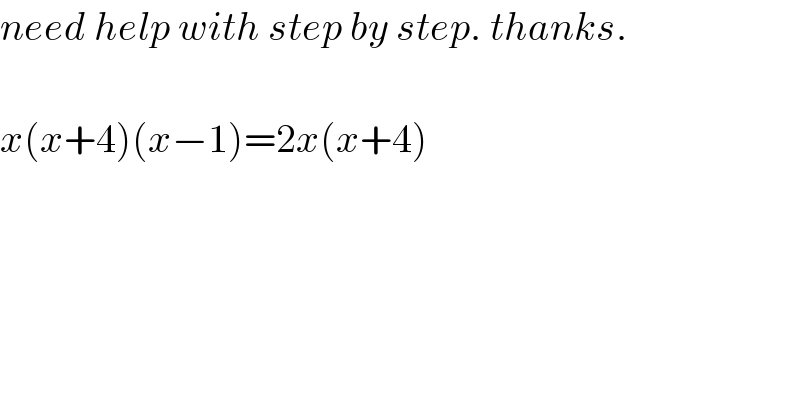Question Number 7234 by WagST last updated on 17/Aug/16

$${need}\:{help}\:{with}\:{step}\:{by}\:{step}.\:{thanks}. \\ $$$$ \\ $$$${x}\left({x}+\mathrm{4}\right)\left({x}−\mathrm{1}\right)=\mathrm{2}{x}\left({x}+\mathrm{4}\right) \\ $$$$ \\ $$$$ \\ $$
Answered by Yozzia last updated on 17/Aug/16
![x(x+4)(x−1)=2x(x+4) (∗) Adding −2x(x+4) on both sides of (∗) gives x(x+4)(x−1)−2x(x+4)=2x(x+4)−2x(x+4) ∵ 2x(x+4)−2x(x+4)=0 ∴ x(x+4)(x−1)−2x(x+4)=0 By the distributive law a(b+c)=ab+bc ⇒ x(x+4)[(x−1)−2]=0 ⇒ x(x+4)[x−3]=0 Now, in general, a product a×b×c×...×z=0 iff at least one of a,b,c,...,z is zero. Hence for x(x+4)(x−3)=0 at least one of x, (x+4) or (x−3) is zero. ∴ x=0 or x=−4 or x=3.](https://www.tinkutara.com/question/Q7235.png)
$${x}\left({x}+\mathrm{4}\right)\left({x}−\mathrm{1}\right)=\mathrm{2}{x}\left({x}+\mathrm{4}\right)\:\:\:\left(\ast\right) \\ $$$${Adding}\:\:−\mathrm{2}{x}\left({x}+\mathrm{4}\right)\:{on}\:{both}\:{sides}\:{of}\:\left(\ast\right)\:{gives} \\ $$$${x}\left({x}+\mathrm{4}\right)\left({x}−\mathrm{1}\right)−\mathrm{2}{x}\left({x}+\mathrm{4}\right)=\mathrm{2}{x}\left({x}+\mathrm{4}\right)−\mathrm{2}{x}\left({x}+\mathrm{4}\right) \\ $$$$\because\:\mathrm{2}{x}\left({x}+\mathrm{4}\right)−\mathrm{2}{x}\left({x}+\mathrm{4}\right)=\mathrm{0} \\ $$$$\therefore\:{x}\left({x}+\mathrm{4}\right)\left({x}−\mathrm{1}\right)−\mathrm{2}{x}\left({x}+\mathrm{4}\right)=\mathrm{0} \\ $$$${By}\:{the}\:{distributive}\:{law}\:{a}\left({b}+{c}\right)={ab}+{bc} \\ $$$$\Rightarrow\:{x}\left({x}+\mathrm{4}\right)\left[\left({x}−\mathrm{1}\right)−\mathrm{2}\right]=\mathrm{0} \\ $$$$\Rightarrow\:{x}\left({x}+\mathrm{4}\right)\left[{x}−\mathrm{3}\right]=\mathrm{0} \\ $$$${Now},\:{in}\:{general},\:{a}\:{product}\:{a}×{b}×{c}×…×{z}=\mathrm{0} \\ $$$${iff}\:{at}\:{least}\:{one}\:{of}\:{a},{b},{c},…,{z}\:{is}\:{zero}. \\ $$$${Hence}\:{for}\:{x}\left({x}+\mathrm{4}\right)\left({x}−\mathrm{3}\right)=\mathrm{0}\:{at}\:{least} \\ $$$${one}\:{of}\:{x},\:\left({x}+\mathrm{4}\right)\:{or}\:\left({x}−\mathrm{3}\right)\:{is}\:{zero}. \\ $$$$\therefore\:{x}=\mathrm{0}\:{or}\:{x}=−\mathrm{4}\:{or}\:{x}=\mathrm{3}. \\ $$
